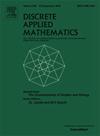超越平面性的图形的公平着色
IF 1
3区 数学
Q3 MATHEMATICS, APPLIED
引用次数: 0
摘要
图的公平着色是任意两个不同色类的大小相差不超过一个的适当着色。如果一个图形可以在平面上绘制,使得没有两条交叉的边有一个共同的端点,那么这个图形就是集成平面图形,如果它可以嵌入在平面上,使得没有两对交叉的边共享两个端点,那么这个图形就是集成平面图形。Zhang、Wang和Xu证明了最大度Δ≥12的每一个ic -平面图和最大度Δ≥13的每一个nic -平面图都是公平的Δ-colorings。在本文中,我们将ic -平面图的阈值从12降低到10,将nic -平面图的阈值从13降低到11。本文章由计算机程序翻译,如有差异,请以英文原文为准。
Equitable coloring of graphs beyond planarity
An equitable coloring of a graph is a proper coloring where the sizes of any two different color classes do not differ by more than one. A graph is IC-planar if it can be drawn in the plane so that no two crossed edges have a common endpoint, and is NIC-planar graph if it can be embedded in the plane in such a way that no two pairs of crossed edges share two endpoints. Zhang, Wang, and Xu proved that every IC-planar graph with maximum degree and every NIC-planar graph with maximum degree have equitable -colorings. In this paper, we reduce the threshold from 12 to 10 for IC-planar graphs and from 13 to 11 for NIC-planar graphs.
求助全文
通过发布文献求助,成功后即可免费获取论文全文。
去求助
来源期刊

Discrete Applied Mathematics
数学-应用数学
CiteScore
2.30
自引率
9.10%
发文量
422
审稿时长
4.5 months
期刊介绍:
The aim of Discrete Applied Mathematics is to bring together research papers in different areas of algorithmic and applicable discrete mathematics as well as applications of combinatorial mathematics to informatics and various areas of science and technology. Contributions presented to the journal can be research papers, short notes, surveys, and possibly research problems. The "Communications" section will be devoted to the fastest possible publication of recent research results that are checked and recommended for publication by a member of the Editorial Board. The journal will also publish a limited number of book announcements as well as proceedings of conferences. These proceedings will be fully refereed and adhere to the normal standards of the journal.
Potential authors are advised to view the journal and the open calls-for-papers of special issues before submitting their manuscripts. Only high-quality, original work that is within the scope of the journal or the targeted special issue will be considered.
 求助内容:
求助内容: 应助结果提醒方式:
应助结果提醒方式:


